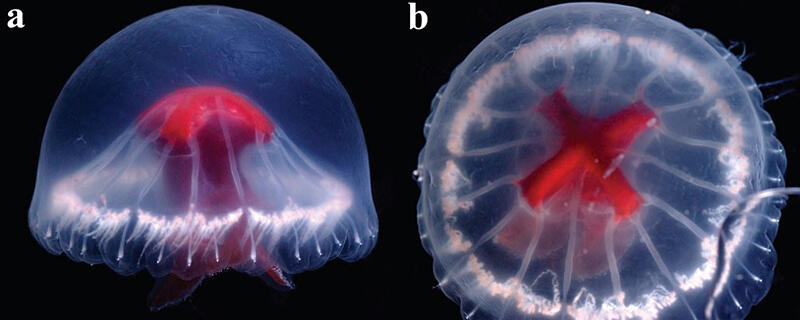A research team led by Senior Researcher Dhugal Lindsay of the Institute for Extra-cutting-edge Science and Technology Avant-garde Research at the Japan Agency for Marine-Earth Science and Technology (JAMSTEC) have discovered and described a new jellyfish species, Santjordia pagesi, and classified it as a new genus and species in a new subfamily named the Santjordiinae. The results of this study were published in the journal Zootaxa.

Provided by JAMSTEC
With the goal of establishing the necessary environmental impact assessment and environmental monitoring technologies to support the sustainable utilization of seafloor mineral resources, JAMSTEC has conducted surveys in various calderas found in the Japan region, focusing on ecosystems in submarine calderas, which are closed environments considered particularly amenable to the mining and pumping of seafloor resources. One of the surveyed areas is the Sumisu Caldera (Also known as the Smith Caldera).
The Sumisu Caldera is located on the volcanic front of the Izu-Ogasawara region (∼460 km south of Tokyo), with a diameter of approximately 10 km (east-west direction). It reaches a depth of over 1,000 m beneath the sea surface within the crater, and its deepest edge measures a depth of 490 m, indicating a considerably closed environment.
During a survey conducted in 2002, the research team discovered and collected a mysterious jellyfish inside the Sumisu Caldera using the unmanned remotely operated vehicle (ROV) Hyper-Dolphin. Morphological analysis suggested that this jellyfish was a completely new and unique species that had never been reported before, but the research team did not encounter another specimen after collecting this one. The description of a new species based on a single individual is usually delayed because of the possibility of deformities to known species caused by sudden mutations or peculiar feeding histories. However, during a 2020 expedition using the unmanned KM-ROV to re-investigate Sumisu Caldera, the research team succeeded in observing and collecting what appears to be a second specimen of the same jellyfish species.
Genetic analysis revealed that this specimen had no closely related species listed in GenBank (a global public genome sequence database). Therefore, the research team collected and genetically analyzed jellyfish species that could be likely relatives of the specimens in the Antarctic Ocean, the Caribbean Sea, the Japan Trench, and other areas of the world.
From this analysis they found that the closest relatives were the large deep-sea bell-shaped jellyfish species Tiburonia granrojo, Deepstaria enigmatica, and Stygiomedusa gigantea. These jellyfish species characteristically lack tentacles on their bell and possess only oral arms around their mouth. Although the newly discovered jellyfish species in this study lacks marginal tentacles, it possesses sub-umbrella tentacles between the margin and oral arms.
It is not possible to specify the most closely related jellyfish taxon of this new species based solely on the genetic analysis of all jellyfish species collected to date. For now, it can only be stated that the new species belongs to the family Ulmaridae. It is also clear that the currently defined family Ulmaridae needs to be divided into several subfamilies. However, since many species have not yet been sampled for genetic analysis, the taxonomic reconsideration of the family should still be postponed. This means that this jellyfish should be classified not only as a new species but also as a new genus of a new subfamily (which is a higher taxonomic group than the genus).
This jellyfish has a bright red stomach that resembles a cross when viewed from above the umbrella. The group assigned the Latin genus name Santjordia, which refers to the red cross of St. George. The Japanese genus name is Sekijuujikurage-zoku. The Latin scientific name pagesi is given in honor of Francesc Pages, a jellyfish taxonomist from Barcelona who passed away at a young age. He was the mentor of Dr. Lindsay.
Despite that surveys have been conducted in various marine areas, S. pagesi has only been found inside the known submarine hydrothermal deposits in the Sumisu Caldera, making it a rare species. Although a polyp generation attached to the seafloor is presumed to exist, these polyps might be attached to specific rocks that are unique to the exposed seafloor resources. Therefore, S. pagesi could potentially contribute to the assessments of the environmental impact of seafloor resource development in the Sumisu Caldera.
Journal Information
Publication: Zootaxa
Title: A new subfamily of ulmarid scyphomedusae, the Santjordiinae, with a description of Santjordia pagesi gen. et sp. nov. (Cnidaria: Scyphozoa: Discomedusae: Semaeostomeae: Ulmaridae) from the Sumisu Caldera, Ogasawara Islands, Japan
DOI: 10.11646/zootaxa.5374.4.5
This article has been translated by JST with permission from The Science News Ltd. (https://sci-news.co.jp/). Unauthorized reproduction of the article and photographs is prohibited.




